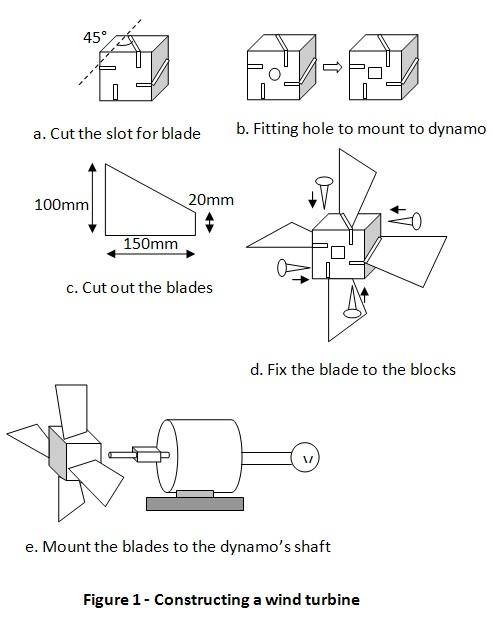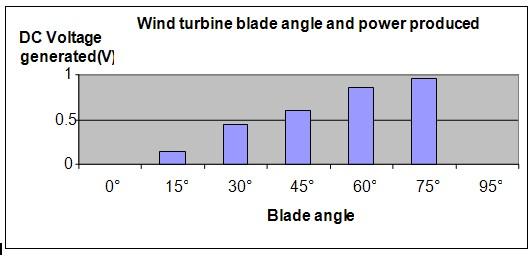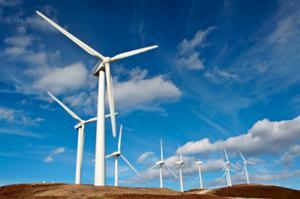| Complexity level: | 7 |
| Project cost ($): | 90 |
| Time required: | 2 days for preparation, 1 day to conduct the science project experiment |
| Material availability: | May be purchased from a hobby store |
| Safety concerns: | Ensure the blades are properly fixed to the wooden block so that they do not come loose when rotating. Drilling and sawing should be performed by an adult. Safety goggles/gloves should be worn. |
Hypothesis
The power generated by the wind turbine will vary depending on the angle at which the blades are positioned and the angle that produces the maximum power output, is 45 degrees.
Overview
Wind power
Wind power is produced when the kinetic energy of the wind is converted into electrical power or mechanical power. Wind turbines are used to generate electrical power while wind mills are used to generate mechanical power from the wind.
Wind energy comes from the kinetic energy of air molecules. This energy is able to drive the blades of a turbine, causing them to rotate. In so doing, the kinetic energy of the wind or air molecules is converted into mechanical energy. This mechanical energy can be further converted into electrical energy by connecting the rotating blades of the turbine to the shaft of a DC motor or dynamo, through a gearing system.
A basic wind turbine system consists of a tower, the blades, a generator, a gear box, cabling and electrical control circuits. The tower provides the required elevation so that the blades can be exposed to stronger winds (generally, the higher the altitude, the stronger the wind). .
Harnessing wind energy is a more environmentally friendly to generate energy (as opposed to burning fossil fuels) because it does not emit any pollutants. Hence, it is important that we understand how to efficiently generate sufficient levels of energy from wind turbines and other sources of "clean energy".
Scientific Terms
Materials
The materials required for this science fair project are:
- A DC motor (or an old bicycle dynamo)
- 1 zinc sheet (thickness 0.5mm, size 750mm x 600mm)
- 1 pair of scissors
- 7 cubic wooden blocks 50mm x 50mm x 50mm
- 1 electric hand drill and drill bits
- 1 set of needle files
- A protractor
- Screws and a screw driver
- a digital voltmeter
- An industrial fan
Procedure
1. The independent variable of this experiment is the angle at which the blades are mounted. . The dependent variable is the amount of voltage generated by the wind turbines. This is measured by using the digital voltmeter. The constants or control variables are the wind speed, the weight of the wooden block and the size of the blades.
2. Using a hacksaw, slots at 0, 15, 30, 45, 60, 75 and 90 degrees are cut out of the 7 cubic wooden blocks to fit in the fan blades as shown in figure 1a below.
3. An electric hand drill is used to perforate the center of the wooden block. The shape of the hole is modified using the needle files in order to fit the shaft of the DC motor or dynamo.
4. The blades to be mounted on the wooden block are cut according to the dimensions as proposed in figure 1c. A total of 28 blades are cut out. There will be 4 blades mounted on each wooden block. The blades will be fixed to the wooden blocks using screws.

5. Caution – Ensure that the blades are fixed firmly to the blocks by the screws. Test them by trying to pull them out. It is dangerous if the blades come loose whilst the turbine is spinning.
6. The first wooden block to be tested is fixed to the shaft of the DC motor or dynamo. The wooden block will be fixed to the shaft using a nut. The assembled turbine with the blades will be placed 1 meter in front of an industrial fan. When the fan is turned on, the blades will start to rotate and a voltage will be produced between the terminal of the DC motor or dynamo. The measured voltage is recorded in the table given below.
7. Step 6 is repeated using the remaining 6 wooden blocks and the measured voltage is recorded in the table provided below.


Results
The results show that increasing the angle of which the wind turbine blades are positioned up to 75° will increase the output voltage. Beyond 75° the output voltage will decrease .
| Blade Angle | 0° | 15° | 30° | 45° | 60° | 75° | 95° |
| DV Volts produced | 0 | 0.15 | 0.45 | 0.6 | 0.85 | 0.95 | 0 |
Plot your results observed into a graph, as shown below.

Conclusion
The hypothesis that the power generated by the wind turbine will vary depending on the angle at which the blades are being positioned is proven to be true. The second hypothesis that the maximum power output occurs at blade angles of 45 degrees is proven to be false.
Wind energy and solar energy are environmentally friendly sources of energy compared to the burning of fossil fuels which causes air pollution resulting in global warming. These clean sources of energy do not result in depletion of our planet's natural resources and are easily accessible in remote areas.
Also consider
This science fair project can also berepeated using blades of different sizes .
You should also try to vary the wind speed and observe if there is any difference in your results.
References
Wind power - http://en.wikipedia.org/wiki/Wind_power
Wind energy basics - http://windeis.anl.gov/guide/basics/index.cfm

